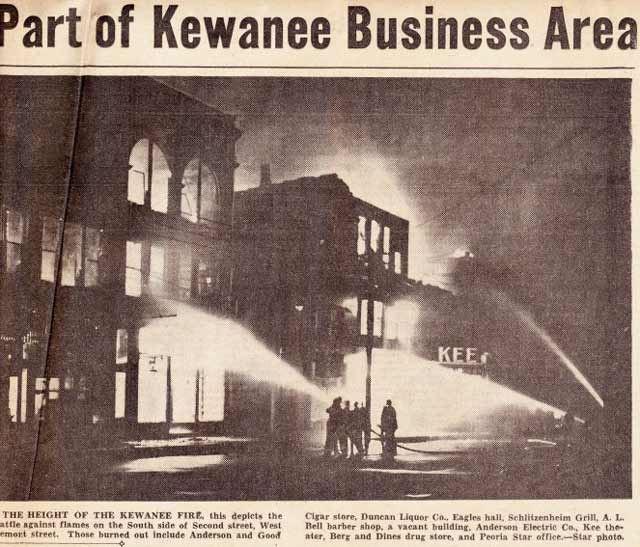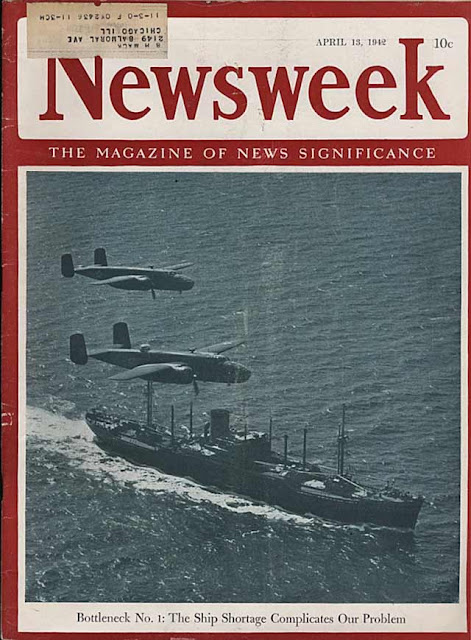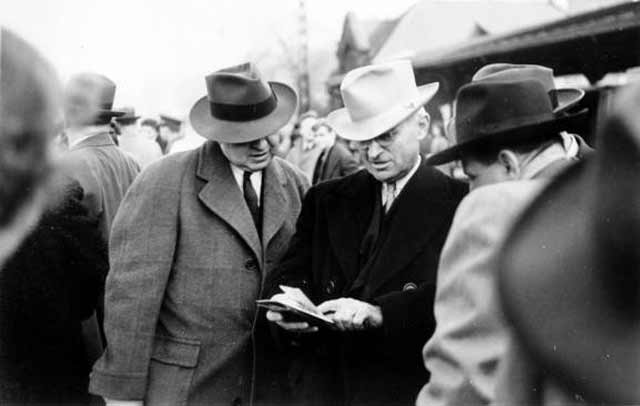Monday 13 April 1942
Battle of the Pacific: The Bataan Death March that began on 10 April continues in the Philippines on 13 April 1942. It is a six-day march to the San Fernando railhead and more groups of men are starting out every day. The roads north from Mariveles and Bagac are full of shuffling men, routinely mistreated, given minimal food and water, and executed if they fail to keep pace. The first groups that began the march from Mariveles on 10 April and Bagac the following day now are beginning to converge at Pilar, where they march together toward the train.
While Bataan and Cebu have fallen, the Allies still maintain a presence in the Philippines. Australian-based B-25s stage through Del Monte Airfield on Mindanao to bomb shipping off Cebu and Davao port installations. They make a second attack on Davao during the day. The US Army Air Force loses one B-17E during this mission. The bombers evacuate personnel on their way back to Australia. Separately, the 5th Air Force sends seven A-24 bombers to attack Lae, New Guinea. The escort of 8 P-40E Kittyhawks of No. 75 Squadron loses one plane.
US Navy submarine USS Grayling, operating off the southwest tip of Shikoku, Japan, torpedoes and sinks Japanese freighter Ryujin Maru.
 |
| Five Liberty Ships under construction at South Portland Shipyard, 13 April 1942. |
After steaming west out of Pearl Harbor for five days at a steady twenty knots through rain, fog, and rough seas, Admiral "Bull" Halsey's Task Force 16 catches up with the task force led by USS Hornet that is heading toward Japan. Hornet carries the Doolittle raiders whose mission is to bomb Tokyo. The combined task force now comprises two aircraft carriers (USS Hornet and Enterprise), three heavy cruisers (Salt Lake City, Northampton, and Vincennes), one light cruiser (Nashville), eight destroyers, and two fleet oilers.
From this point forward, the combined task forces (Halsey is in overall command) will continue toward Japan with USS Enterprise providing scouting and air cover. Unknown to the Americans, Japanese Naval Intelligence already has detected their radio transmissions (at this point Halsey imposed radio silence) and knows that something is up. However, the Japanese await word from their naval picket line ships stationed about 600 miles east of Japan before taking any action.
Battle of the Indian Ocean: Japanese attacks in the Irrawaddy River valley toward the Yenangyaung oil fields are forcing the British back to the northwest. The British still hope to hold the oil fields, but it is not looking good. They now are using the Burma Frontier Force, not real troops but an internal security unit, as infantry.
Eastern Front: In the Crimea, Soviet General Kozlov gradually is bringing his forces back to their starting points after his failed fourth offensive on the Parpach Narrows. His Crimean Front has taken massive casualties in these offensives, but Stalin is contemplating launching a fifth offensive against the advice of his generals. The Luftwaffe, which is building up its power in the area to that of an Air Fleet that usually supports an entire Army Group, is working to isolate Crimean Front. The constant air attacks are causing Kozlov's men to run down their supplies.
Battle of the Indian Ocean: Japanese attacks in the Irrawaddy River valley toward the Yenangyaung oil fields are forcing the British back to the northwest. The British still hope to hold the oil fields, but it is not looking good. They now are using the Burma Frontier Force, not real troops but an internal security unit, as infantry.
 |
| Time magazine for 13 April 1942 features Sir Stafford Cripps on the cover. His mission to India to arrange a deal with Indian nationalists recently failed. |
General Seydlitz's Operation Brückenschlag relief attack toward Demyansk continues making slow progress north along the Lovat River toward Ramushevo. Simply advancing, however, is no guarantee of success. His forces already have taken 10,000 casualties and reinforcements are not available in abundance. The original OKH plan was for Seydlitz to take Ramushevo before authorizing a breakout from the Demyansk and Kholm pockets, but conditions in the Demyansk and Kholm pockets are deteriorating and now there is no certainty that Seydlitz' men can take Ramushevo before the spring thaw ("Rasputitsa") stops things completely. As General Franz Halder notes cryptically today in his war diary, "Difficult situation at Kholm."
 |
| A fire devastates Kewanee, Illinois, in the early morning hours of 13 April 1942 (The Kewanee Historical Society). |
Realizing the danger, Hitler authorizes a breakout by Generalmajor H. Zorn's II Corps that maintains the integrity of the Demyansk pocket - a difficult feat - to begin on 14 April. This is Operation Fallreep. It will be led by the Totenkopf SS Division.
At Fuhrer Headquarters, General Franz Halder is keeping close track of troop losses. The original plan was for casualties to diminish during the winter and spring months, but that has not happened. Instead, casualties have remained high. Halder notes the following casualty figures:
- First ten days of March: 3478 (58 officers)
- Second ten days of March: 3139 (67 officers)
- Third ten days of March: 5947 (37 officers)
These are not extraordinary figures by the standards of World War II, but the show that a period that was supposed to provide a respite has done nothing of the sort.
 |
| An Army MP on duty in Columbus, Ohio, 13 April 1942. |
European Air Operations: The Luftwaffe raids Hull at 00:05 on 13 April. There is some property damage, four killed, and five seriously wounded. The bombs drop in the Willerby Road/Woodlands Road/Springhead Ave. area.
RAF Bomber Command schedules a light day of activity after the heavy attack on Essen on the night of 12/13 April. It sends 47 aircraft on minelaying operations in the Frisian Islands and off the German coast, four Wellington bombers over Boulogne, and three bombers on leaflet flights. It loses a Stirling bomber during the minelaying operation.
Battle of the Atlantic: As 16-freighter QP-10 continues heading from Murmansk to Iceland with a heavy escort, Axis attacks increase in intensity. While the PQ convoys heading to Murmansk are better known, the return convoys turn into deadly gauntlets north of Norway. Today, German destroyers Z24 and Z25 search for the convoy but turn back due to rough weather, but the Germans have multiple ways to attack Arctic convoys and use all of them today. U-435 attacks Royal Navy destroyer HMS Punjabi, but misses, and U-209 also attempts an attack but fails. These actions, however, are only a prelude to the action.
2021
Battle of the Atlantic: As 16-freighter QP-10 continues heading from Murmansk to Iceland with a heavy escort, Axis attacks increase in intensity. While the PQ convoys heading to Murmansk are better known, the return convoys turn into deadly gauntlets north of Norway. Today, German destroyers Z24 and Z25 search for the convoy but turn back due to rough weather, but the Germans have multiple ways to attack Arctic convoys and use all of them today. U-435 attacks Royal Navy destroyer HMS Punjabi, but misses, and U-209 also attempts an attack but fails. These actions, however, are only a prelude to the action.
U-436 (Kptlt. Günther Seibicke), on its fifth patrol out of Kirkenes, begins the attacks on QP-10 at 01:00 when it torpedoes and sinks 5823-ton Russian freighter Kiev. The ship sinks within seven minutes and there are six dead, including one woman passenger.
U-435 (Kptlt. Siegfried Strelow), on its third patrol out of Kirkenes, follows up U-436's success at 03:30 when Strelow torpedoes and sinks 6008-ton Panamanian ore freighter El Occidente. As with many ore freighters hit by torpedoes, El Occidente sinks quickly and there is no time to launch the lifeboats. There are 20 dead and 21 survivors.
Junkers Ju 88 medium bombers appear over QP-10 at 05:00 and shadow it for an hour. When they attack around dawn, they hit 5486-ton British ore freighter Harpalion. With its rudder and steering gear inoperative, the crew abandons ship after repairs fail. A destroyer escort, HMS Fury, then shells the ship to keep it from falling into enemy hands but fails. U-435 reports later finding the hulk and sinks it with a spread of three torpedoes at 15:50.
Thousands of miles to the southwest, U-154 (KrvKpt. Walther Kölle), on its second patrol out of Lorient, gets another victory in a successful patrol in the Caribbean. Kölle, after a grueling 16-hour chase, torpedoes and sinks 8032-ton British tanker Empire Amethyst at 05:52 about 150 miles northeast of Aruba. The tanker erupts into a fireball and breaks in two, with the stern sinking within five minutes. There are no survivors of the 47-man crew.
U-402 (Kptlt. Siegfried Freiherr von Forstner), on its third patrol out of St. Nazaire, torpedoes 5249-ton British freighter Empire Progress south of Cape Race at 23:26. It takes four torpedoes, one of them a dud, but Empire Progress finally sinks at 00:17 on the 14th. The ship was a member of Convoy ON-80 that had been dispersed. there are 12 dead and 38 survivors.
 |
| Fishermen's Club Banquet, Biola University, 13 April 1942 (Biola University Digital Archive alumni1-012). |
U-123 (Kptlt. Reinhard Hardegen), on its eighth patrol out of Lorient, continues a highly successful patrol off the east coast of the United States with two sinkings in rapid succession. Using his last torpedo, Hardegen torpedoes and sinks 2609-ton US sugar freighter Leslie about three miles southeast of the Hetzel Shoals Gas Buoy at 05:11. There are four dead and 28 survivors.
Hardegen follows this up by sinking 2647-ton Swedish freighter Korsholm. at 07:45. Hardegen, now out of torpedoes after already sinking or damaging nine ships on this patrol, uses his deck gun to dispose of Korsholm about 70 miles off Cape Canaveral. There are nine dead and 17 survivors. With this sinking, Hardegen provest that he is a master of the economy of force and efficient use of his resources. He also demonstrates the usefulness of deck guns. And, not to give anything away - but he's not through yet on this patrol.
Off Falmouth, naval trawler HMT Lord Snowden collides with another ship and sinks.
German landing craft PiLB 210 is lost today for uncertain reasons.
 |
| Newsweek magazine, 13 April 1942 features a cover story about the "ship shortage." |
Battle of the Mediterranean: The Luftwaffe bombing offensive against Malta continues and today sinks Royal Navy trawler HMT Coral.
Royal Navy submarine HMS Thrasher sinks 2297-ton German freighter Atlas near Benghazi.
Battle of the Black Sea: Soviet freighter Partizan Zheleznay hits a mine and sinks in the Kerch Gulf. There are six deaths. This is part of the Luftwaffe's interdiction of supplies to General Kozlov's Crimean Front.
Propaganda: German radio announces that mass graves of murdered Polish officers have been found in Katyn, Poland. It is implied that these men were murdered by Soviet occupation forces prior to Operation Barbarossa. The Germans begin an investigation.
Iranian/Japanese Relations: Iran breaks diplomatic relations with the Empire of Japan. This is likely provoked by the recent Japanese Indian Ocean Raid.
Propaganda: German radio announces that mass graves of murdered Polish officers have been found in Katyn, Poland. It is implied that these men were murdered by Soviet occupation forces prior to Operation Barbarossa. The Germans begin an investigation.
Iranian/Japanese Relations: Iran breaks diplomatic relations with the Empire of Japan. This is likely provoked by the recent Japanese Indian Ocean Raid.
 |
| Life magazine for 13 April 1942 features Army Supply Chief General Somervell. |
US Military: Upon Admiral Chester Nimitz's recommendation, Vice Admiral Robert L Ghormley is appointed Commander-in-Chief South Pacific (COMSOPAC). Ghormley is "connected" and a good friend of President Roosevelt somewhat along the lines of Harry Hopkins. Nimitz's first choice was Admiral Pye, who temporarily held Nimitz's own position for a brief period after Pearl Harbor, but Pye remains "in the doghouse" because he recalled the Wake Island relief attempt in December 1941 (Wake fell immediately thereafter, though that was hardly Pye's fault). Ghormley is a staff officer without recent active commands and no aircraft carrier experience, and carriers recently have become the focus of the war in the Pacific, so he is operating at somewhat of a disadvantage. The assignment seems rushed and sudden, but Ghormley does have a long resume of experience both in the United States and abroad at the highest level of naval affairs.
German Military: Count Claus von Stauffenberg, currently serving in the organizational department of the OKH, makes a rare appearance in General Franz Halder's war diary today. He reports that "OKW (overall military command organization) shows a desire to activate troops of its own." This, of course, would diminish the power of OKH, which controls the army and considers the Eastern Front its own preserve. The growing tension between the influence of OKW and OKH over army operations is a recurrent feature of the middle war years.
British Military: The military announces that Rear-Admiral Lord Mountbatten has been appointed Chief of Combined Operations. He now is a member of the British Chiefs of Staff Committee. Appointment effective 18 March 1942.
British Military: The military announces that Rear-Admiral Lord Mountbatten has been appointed Chief of Combined Operations. He now is a member of the British Chiefs of Staff Committee. Appointment effective 18 March 1942.
 |
| Anton Schmid, executed by his superiors on 13 April 1942. |
Holocaust: Anton Schmid (January 9, 1900 – April 13, 1942), a German sergeant (Feldwebel), is executed in Vilnius, Lithuania. Arrested in late January and condemned to death on 25 February 1942, Schmid is shot by his superiors for helping about 250 Jewish men, women, and children escape from extermination by the Nazi SS during the European Jewish Holocaust. Yad Vashem will recognize Schmid as Righteous Among the Nations.
British Homefront: A horrible friendly-fire accident takes place at Imber, Wiltshire, UK. In the "Imber Incident," a crowd of spectators is watching a firepower demonstration when pilot error and poor weather lead to a tragedy. Six Hawker Hurricanes and six Supermarine Spitfires fly in formation and fire their guns at a target (stationary vehicles). Everything goes well until one of the Hurricane pilots mistakenly fires at the crowd of spectators instead of the target. There are 25 military casualties (16 officers) and 71 wounded. The pilot is later found guilty of error in mistaking the spectators as target dummies but remains in the service.
American Homefront: Golfer Byron Nelson wins the Masters golf tournament in a playoff against Ben Hogan. This is the last Masters tournament until 1946.
April 2, 1942: Doolittle Raiders Leave Port
April 3, 1942: Japanese Attack in Bataan
April 4, 1942: Luftwaffe Attacks Kronstadt
April 5, 1942: Japanese Easter Sunday Raid on Ceylon
April 6, 1942: Japanese Devastation In Bay of Bengal
April 7, 1942: Valletta, Malta, Destroyed
April 8, 1942: US Bataan Defenses Collapse
April 9, 1942: US Defeat in Bataan
April 10, 1942: The Bataan Death March
April 11, 1942: The Sea War Heats Up
April 12, 1942: Essen Raids Conclude Dismally
April 13, 1942: Convoy QP-10 Destruction
April 14, 1942: Demyansk Breakout Attempt
April 15, 1942: Sobibor Extermination Camp Opens
April 16, 1942: Oil Field Ablaze in Burma
April 17, 1942: The Disastrous Augsburg Raid
April 18, 1942: The Doolittle Raid bombs Japan
April 19, 1942: British in Burma Escape
April 20, 1942: The Operation Calendar Disaster
April 21, 1942: Germans Relieve Demyansk
Wild rumors spread after the incident about the number of deaths, the identity of the pilot as American (Sergeant William McLachlan is actually British, KIA 29 June 1942), and other matters. A similar live-fire demonstration on 16 April 1942 for Winston Churchill and US General George Marshall proceeds without incident.
American Homefront: Golfer Byron Nelson wins the Masters golf tournament in a playoff against Ben Hogan. This is the last Masters tournament until 1946.
The Federal Communications Commission reduces the minimum weekly programming time for television stations from 15 hours to 4 hours. This minimum will not be raised again until 1946. The US War Production Board already, on 1 April 1942, has halted the production of television and radio sets for domestic use. Television programs on the air at this time include CBS Television Quiz, The Face of War, CBS Television News, Boxing from Jamaica Arena, Stars of Tomorrow, The Adam Hats Sports Parade: Wrestling at Ridgewood Grove, and Sports with Bob Edge. Many of these and other programs (12 in total) will end in May or June 1942 due to these relaxed FCC requirements.
Future History: Isaac Brown is born in Memphis, Tennessee. He becomes a utility player for the Detroit Tigers from 1969 through 1974. "Ike" Brown singled in the winning runs in Game 3 of the 1972 ALCS. He becomes a popular figure in Detroit, beginning each day saying "It's a beautiful day" regardless of the weather. Isaac Brown passes away on 17 May 2001.
April 1942
April 1, 1942: Convoys Come to the USAApril 2, 1942: Doolittle Raiders Leave Port
April 3, 1942: Japanese Attack in Bataan
April 4, 1942: Luftwaffe Attacks Kronstadt
April 5, 1942: Japanese Easter Sunday Raid on Ceylon
April 6, 1942: Japanese Devastation In Bay of Bengal
April 7, 1942: Valletta, Malta, Destroyed
April 8, 1942: US Bataan Defenses Collapse
April 9, 1942: US Defeat in Bataan
April 10, 1942: The Bataan Death March
April 11, 1942: The Sea War Heats Up
April 12, 1942: Essen Raids Conclude Dismally
April 13, 1942: Convoy QP-10 Destruction
April 14, 1942: Demyansk Breakout Attempt
April 15, 1942: Sobibor Extermination Camp Opens
April 16, 1942: Oil Field Ablaze in Burma
April 17, 1942: The Disastrous Augsburg Raid
April 18, 1942: The Doolittle Raid bombs Japan
April 19, 1942: British in Burma Escape
April 20, 1942: The Operation Calendar Disaster
April 21, 1942: Germans Relieve Demyansk



No comments:
Post a Comment